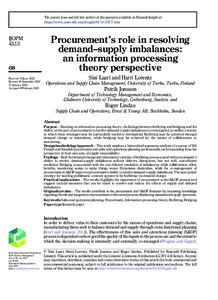Procurement's role in resolving demand – supply imbalances: an information processing theory perspective
Laari Sini; Lorentz Harri; Jonsson Patrik; Lindau Roger
https://urn.fi/URN:NBN:fi-fe2023042137985
Tiivistelmä
Purpose
Drawing on information processing theory, the linkage between buffering and bridging and the ability on the part of procurement to resolve demand–supply imbalances is investigated, as well as contexts in which these strategies may be particularly useful or detrimental. Buffering may be achieved through demand change or redundancy, while bridging may be achieved by the means of collaboration or monitoring.
Design/methodology/approach
This study employs a hierarchical regression analysis of a survey of 150 Finnish and Swedish procurement and sales and operations planning professionals, each responding from the perspective of their own area of supply responsibility.
Findings
Both the demand change and redundancy varieties of buffering are associated with procurement's ability to resolve demand–supply imbalances without delivery disruptions, but not with cost-efficient resolution. Bridging is associated with the cost-efficient resolution of imbalances: while collaboration offers benefits, monitoring seems to make things worse. Dynamism diminishes, while the co-management of procurement in S&OP improves procurement's ability to resolve demand–supply imbalances. The most potent strategy for tackling problematic contexts appears to be buffering via demand change.
Practical implications
The results highlight the importance of procurement in the S&OP process and suggest tactical measures that can be taken to resolve and reduce the effects of supply and demand imbalances.
Originality/value
The results contribute to the procurement and S&OP literature by increasing knowledge regarding the role and integration of procurement to the crucial process of balancing demand and supply operations.
Kokoelmat
- Rinnakkaistallenteet [27094]
